1995 PONTIAC PONTIAC maintenance
[x] Cancel search: maintenancePage 261 of 354
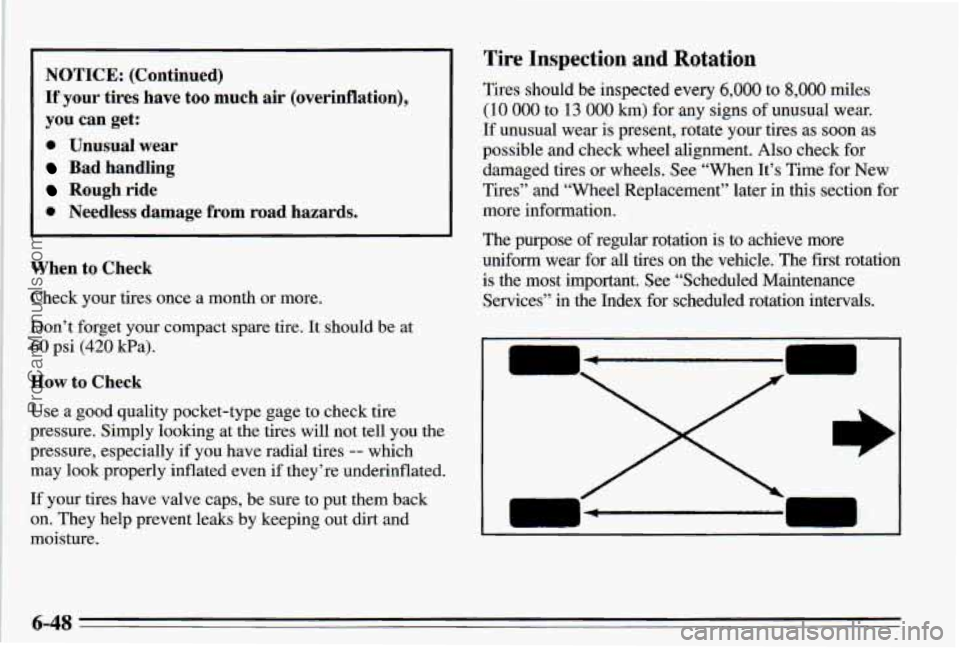
NOTICE: (Continued)
If your tires have too much air (overinflation),
you can get:
0 Unusual wear
Bad handling
Rough ride
0 Needless damage from road hazards.
P en to Check
Check your tires once a month or more.
,Don’t forget your compact spare tire.
It should be at
60 psi (420 kPa).
How to Check
Use a good quality pocket-type gage to check tire
pressure. Simply looking at the tires will not tell you the
pressure, especially if you have radial tires
-- which
may look properly inflated even
if they’re underinflated.
If your tires have valve caps, be sure to put them back
on. They help prevent leaks by keeping out dirt and
moisture.
Tire Inspection and Rotation
Tires should be inspected every 6,000 to 8,000 miles
(10 000 to 13 000 km) for any signs of unusual wear.
If unusual wear is present, rotate your tires as soon as
possible and check wheel alignment.
Also check for
damaged tires or wheels. See “When It’s Time for New
Tires” and “Wheel Replacement” later in this section for
more information.
The purpose of regularrotation is to achieve more
uniform wear for
all tires on the vehicle. The first rotation
is the most important. See “Scheduled Maintenance
Services”
in the Index for scheduled rotation intervals.
I
n
6-48
ProCarManuals.com
Page 274 of 354

Underbody Maintenance Chemical Paint Spotting
Chemicals used for ice and snow removal and dust Some weather and atmospheric conditions CZUI create
control can collect
on the underbody. If these are not a chemical fallout, Airborne pollutants can fall upon
removed, accelerated corrosion (rust) can occur on the and
attack painted surfaces on your vehicle. This
underbody parts such as %el lines, frame, floor pan, and damage can take two forms: blotchy, ringlet-shaped
exhaust system even though
they have corrosion discolorations,
and small irregular dark spots etched
protection. into the
paint surface.
At least every spring, flush these materials from the Although no defect in the paint job causes this, Pontiac
underbody with plain water. Clean any areas where mud will repair, at
no charge to the owner, the surfaces of
and other debris can collect.
Dirt packed in closed areas new vehicles damaged by this fallout condition within
of the frame should be loosened before being flushed.
12 months or 12,000 miles (20 000 km) of purchase,
Your dealer or an underbody vehicle
washing system whichever comes first.
can
do this for you.
Fiberglass Springs
1 NOTICE: I
Don’t use corrosive or acidic cleaning agents,
engine degreasers, aluminum cleaning agents or other harsh solvents to clean fiberglass springs;
they’ll damage the springs.
6-61
ProCarManuals.com
Page 285 of 354

Normal Maintenance Replacement Parts
Air Cleaner Filter
Battery
All Engines ............................. A1208C
3.1L (Code
M) ......................... 525 CCA
3.4L (Code
M) ......................... 690 CCA
3.1L (Code
M) ............................. PF47
3.4L (Code
X) .............................. PF5 1
3.1L (Code M)
.......................... CV892C
3.4L (Code
X) ........................... CV895C
All Engines
............................... RC27
3.1L (Code
M) ....................... oR44LTSM6
3.4L
(Code X) ......................... oR42LTSM
Engine Oil Filter
PCV
Valve
Radiator Cap
Spark Plugs
Gap: 0.060” (1 52 mm)
Gap: 0.045” (1.14 mm) I
Air Conditioning Refrigerants
Not all air conditioning refrigerants are the same. If
the air conditioning system in your vehicle needs
refrigerant, be sure the proper refrigerant is used.
If
you’re not sure, ask your Pontiac dealer. For additional
information, see your “Warranty and Owner1 Assistance
Information” booklet.
ProCarManuals.com
Page 288 of 354
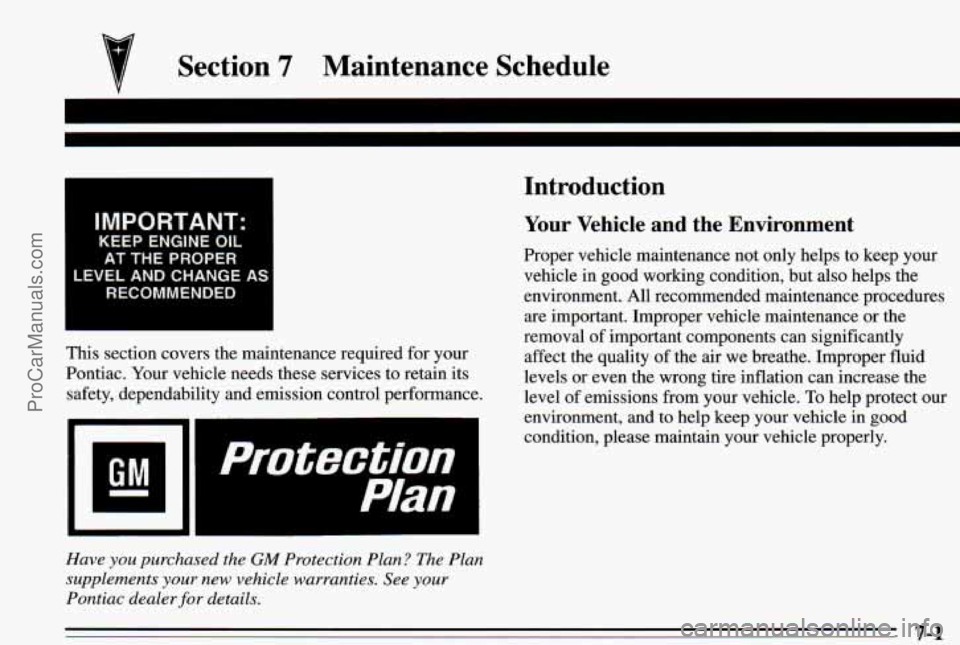
Section 7 Maintenance Schedule
IMPORTANT:
KEEP ENGINE OIL
AT THE PROPER
LEVEL AND CHANGE
AI
RECOMMENDED
This section covers the maintenance required for your
Pontiac. Your vehicle needs these services to retain its
safety, dependability and emission control performance.
GM protection I
Have you purclzased the GM Protection Plan? The Plan
supplements
your new vehicle warranties. See your
Pontiac dealer for details.
Introduction
Your Vehicle and the Environment
Proper vehicle maintenance not only helps to keep your
vehicle in
good working condition, but also helps the
environment. All recommended maintenance procedures are important. Improper vehicle maintenance or the
removal of important components can significantly
affect the quality
of the air we breathe. Improper fluid
levels or even the wrong tire inflation can increase the level of emissions from your vehicle.
To help protect our
environment, and to help keep
your vehicle in good
condition, please maintain your vehicle properly.
7-1 ProCarManuals.com
Page 289 of 354
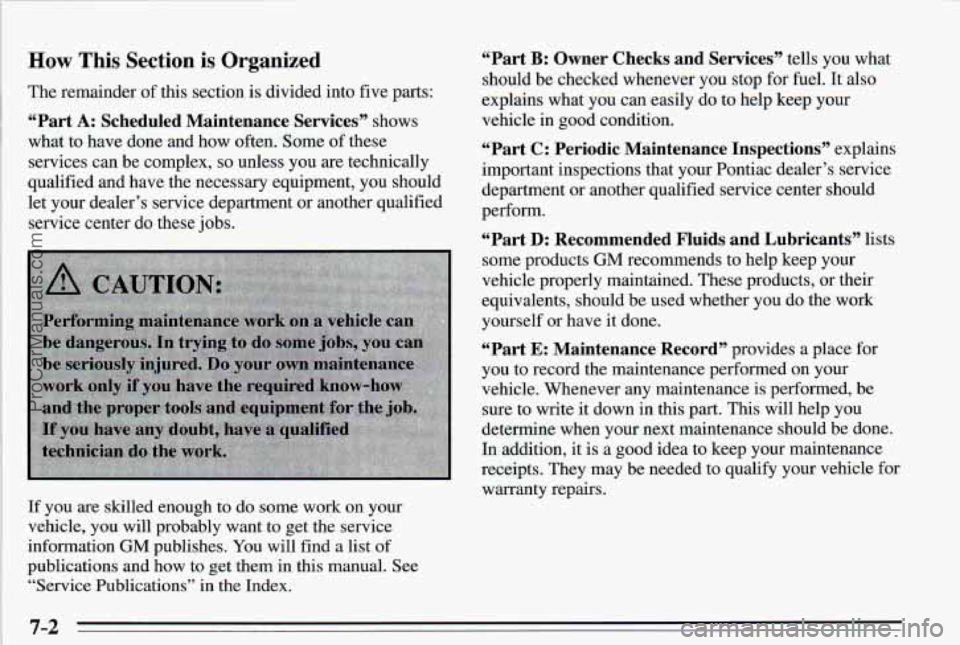
How This Section is Organized
The remainder of this section is divided into five parts:
“Part A: Scheduled Maintenance Services” shows
what to have done and how often. Some
of these
services can be complex,
so unless you are technically
qualified and have the necessary equipment, you should
let your dealer’s service department or another qualified
service center do these jobs.
If you are skilled enough to do some work on your
vehicle, you will probably want to get the service
information
GM publishes. You will find a list of
publications and how to get them in this manual. See
“Service Publications”
in the Index.
“Part B: Owner Checks and Services” tells you what
should be checked whenever you stop
for fuel. It also
explains what you
can easily do to help keep your
vehicle
in good condition.
“Part C : Periodic Maintenance Inspections” explains
important inspections that your Pontiac dealer’s service
department or another qualified service center should
perform.
“Part D: Recommended Fluids and Lubricants” lists
some products
GM recommends to help keep your
vehicle properly maintained. These products, or their
equivalents, should be used whether you do the work
yourself or have it done.
“Part E: Maintenance Record” provides a place for
you to record the maintenance performed on your
vehicle. Whenever any maintenance is performed, be
sure to write it down in this part. This will help you
determine when your next maintenance should be done.
In addition,
it is a good idea to keep your maintenance
receipts. They may be needed to qualify your vehicle for
warranty repairs.
7-2 ProCarManuals.com
Page 290 of 354
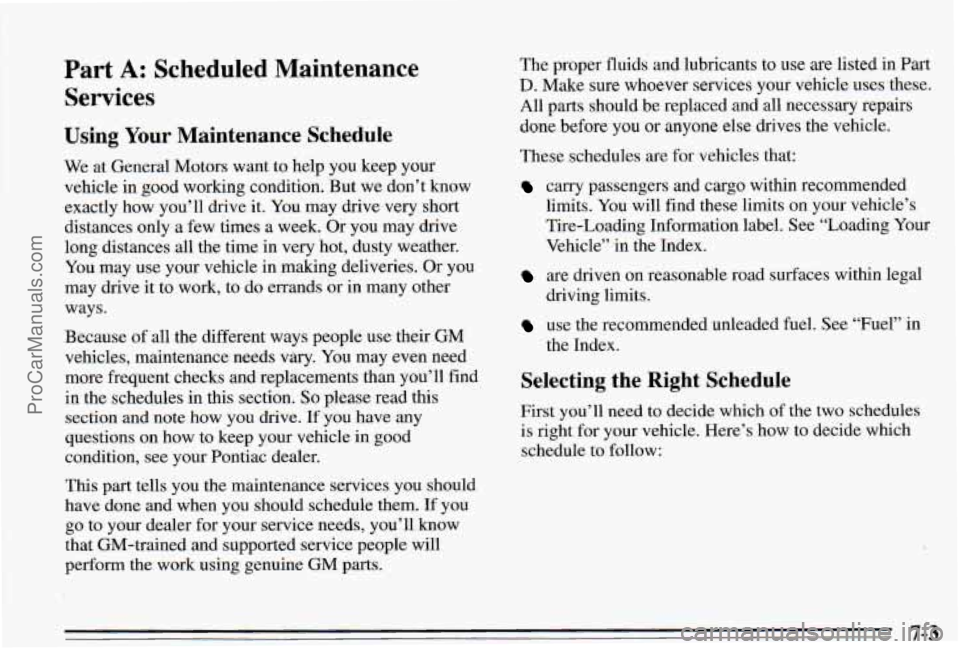
Part A: Scheduled Maintenance
Services
Using Your Maintenance Schedule
we at Gen ~ ~11 Motors want to help you keep your
vehicle in good workmg condition. But we don’t know
exactly how you’ll drive
it. You may drive very short
distances only a few times a week. Or you may drive
long distances all the time in very hot, dusty weather.
You may use your vehicle in making deliveries. Or you
may drive it to work, to do errands or in many other
ways.
Because of all the different ways people use their
GM
vehicles, maintenance needs vary. You may even need
more frequent checks and replacements than you’ll find
in the schedules in this section.
So please read tlvs
section and note how you drive. If you have any
questions on how to keep your vehicle in good
condition, see your Pontiac dealer.
This
part tells you the maintenance services you should
have done and when you should schedule them. If you
go to your dealer for your service needs, you’ll know
that GM-trained and supported service people will
perform the work using genuine
GM parts. The proper fluids
and lubricants to
use are listed in Part
D. Make sure whoever services your vehicle uses these.
All parts should be replaced and all necessary repairs
done before
you or anyone eke drives the vehicle.
These schedules are for vehicles that:
cany passengers and cargo within recommended
limits. You will find these limits on your vehicle’s
Tire-Loading Information label. See “Loading Your
Vehicle”
in the Index.
are driven on reasonable road surfaces within legal
use the recommended unleaded fuel. See “Fuel” in
driving
limits.
the Index.
Selecting the Right Schedule
First you’ll need to decide which of the two schedules
is right for your vehicle. Here’s how to decide which
schedule to follow:
7-3 ProCarManuals.com
Page 291 of 354

Maintenance Schedule
Schedule I Definition
Follow Maintenance Schedule I if any one of these is
true for your vehicle:
0 Most trips are less than 5 to 10 miles (8 to 16 km).
This is particularly important when outside
temperatures are below freezing.
0 Most trips include extensive idling (such as frequent
driving in stop-and-go traffic).
0 Most trips are through dusty areas.
0 You frequently tow a trailer or use a carrier on top of
Schedule
I should also be followed if the vehicle is used
for delivery service, police, taxi, or other commercial
application. your vehicle.
=Schedule
I Intervals
Every 3,000 Miles (5 000 km) or 3 Months,
Whichever
Occurs First
Every
6,000 Miles (10 000 km) or 6 months,
Whichever
Occurs First
At 6,000 Miles (10 000 km) - Then Every 12,000
Miles (25
000 km)
Tire Rotation
Every 15,000 Miles (25 000 km)
Air Cleaner Filter Inspection, if driving in dusty conditions
Every 30,000 Miles (50 000 km)
Air Cleaner Filter Replacement
Spark Plug Replacement
Spark Plug Wire Inspection
Fuel Tank, Cap and Lines Inspection
Engine Accessory Drive Belt Inspection (or every
24 months, whichever occurs first)
Cooling System Service (or every 24 months,
whichever occurs first)
Engine Oil and Filter Change
Chassis Lubrication
Every 50,000 Miles (83 000 km)
At 60,000 Miles (100 000 km) - Then Every
15,000 Miles (25 000 km)
Automatic Transaxle Service (severe conditions only)
Camshaft Timing Belt Inspection (3.4L Code
X engine only)
7-4
ProCarManuals.com
Page 292 of 354
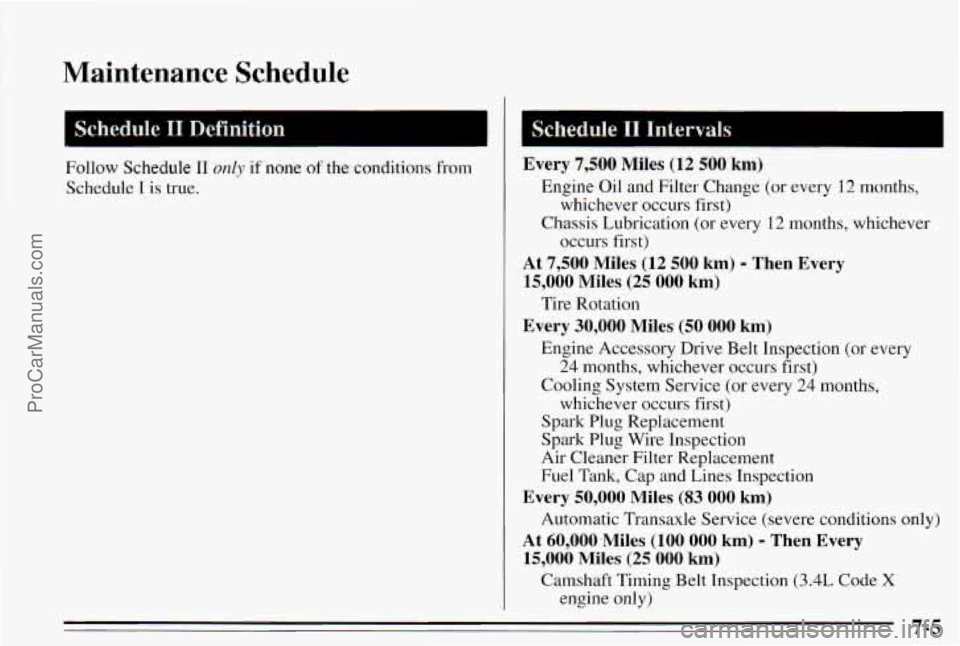
Maintenance Schedule
1
Follow Schedule IT only if none of the conditions from
Schedule
I is true.
Schedule I1 Intervals
Every 7,500 Miles (12 500 km)
whichever occurs first)
occurs first)
Engine
Oil and Filter Change (or every 12 months,
Chassis Lubrication (or every
12 months, whichever
At 7,500 Miles (12 500 km) - Then Every
15,000 Miles
(25 000 km)
Every 30,000 Miles (50 000 km)
Tire Rotation
Engine Accessory Drive Belt Inspection
(or every
24 months, whichever occurs first)
Cooling System Service (or every
24 months,
whichever occurs first)
Spark
Plug Replacement
Spark Plug Wire Inspection
Air Cleaner Filter Replacement
Fuel Tank, Cap and Lines Inspection
Every 50,000 Miles (83 000 knl)
Automatic Transaxle Service (severe conditions only)
At 60,000 Miles (100 000 km) - Then Every
15,000 Miles (25 000 km)
Camshaft Timing Belt Inspection (3.4L Code X
engine only)
7-5 ProCarManuals.com